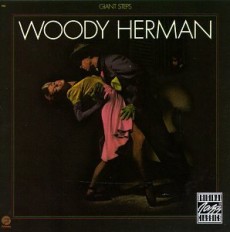
Daily Dose Of Jazz…
Woody Herman was born Woodrow Charles Thomas Herman on May 16, 1913 in Milwaukee, Wisconsin. His father had a deep love for show business and this influenced him at an early age. As a child he worked as a Vaudeville singer and tap-dancer, then started to play the clarinet and saxophone by age 12.
1936 saw him joining the Tom Gerun band and his first recorded vocals were Lonesome Me and My Heart’s at Ease. He also performed with the Harry Sosnick Orchestra, Gus Arnheim and Isham Jones, the latter writing numerous popular songes including It Had To Be You. When Jones retired Woody acquired the orchestra, which became known for its orchestrations of the blues. They first recorded for the Decca label as a cover band, eventually getting their first hit with Woodchopper’s Ball in 1939.He went on to have hits with The Golden Wedding and Blue Prelude.
As bebop was gradually replacing swing Herman commissioned Dizzy Gillespie as an arranger and he provided him three arrangements of Woody‘n You, Swing Shift and Down Under in 1942, heralding a change in the music. By 1945 Herman was with Columbia Records, recording the First Herd, the very successful Laura, the theme song to the 1944 movie of the same name. That group became famous for its progressive jazz that was heavily influenced by Duke Ellington and Count Basie. By the end of 1946 the big band era was over and he disbanded his only financially profitable group.
In 1947, Herman organized the Second Herd that remained together until 1987. This band was also known as The Four Brothers Band derived from the song and featured three tenor and one baritone saxophone of Zoot Sims, Serge Chaloff, Herbie Steward and Stan Getz. In the band was also Al Cohn, Gene Ammons, Lou Levy, Oscar Pettiford, Terry Gibbs and Shelly Manne and they had hits with Early Autumn and The Goof and I.
Herman would go on to perform in movies with Billie Holiday and Louis Armstrong, record for RCA, Capitol, MGM and Verve record labels, put together his Third Herd and variations of the New Thundering Herd and by the Seventies was touring and working more in jazz education by offering workshops and taking on younger sidemen.
The 1980s saw Herman’s return to straight-ahead jazz, dropping some of the newer rock and fusion approaches he had used the previous decade. He continued to perform with his health in decline, chiefly to pay back taxes that were owed because of his business manager’s bookkeeping in the 1960s. Herman owed the IRS millions of dollars and was in danger of eviction from his home. He eventually passed leadership duties to reed section leader Frank Tiberi.
Clarinetist, alto and soprano saxophonist, singer and big band leader Woody Herman was awarded two Grammys for Best Big Band Jazz Album for Encore and Giant Steps, The Grammy Lifetime Achievement Award, had won Down Beat, Esquire and Metronome polls. He was the feature of a documentary film titled Woody Herman: Blue Flame- Portrait of a Jazz Legend, and was a featured half-time performer at Super Bowl VII. He passed away on October 29, 1987.
![]()
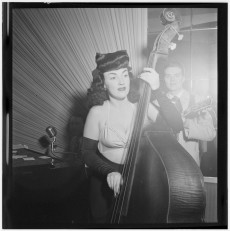
Daily Dose Of Jazz…
Bonnie Wetzel was born Bonnie Jean Addleman on May 15, 1926 in Vancouver, Washington. She learned violin as a child and was an autodidact on bass.
She played with Ada Leonard in an all-female ensemble and soon after worked in a trio with Marian Grange. Bonnie married trumpeter Ray Wetzel in 1949 and the pair worked in the Tommy Dorsey Orchestra in 1951.
Wetzel played in the Beryl Booker Trio with Elaine Leighton in 1953. They toured Europe in 1953-54 and recorded for Discovery Records. She also played with Herb Ellis, Charlie Shavers, Roy Eldridge and Don Byas. During the 1950s she freelanced in New York City. Double-bassist Bonnie Wetzel, who never led a recording session in her short career, passed away on February 12, 1965, at the age of 38.
![]()
More Posts: bass
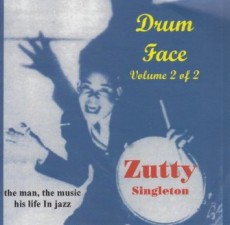
Daily Dose Of Jazz…
Born Arthur James Singleton on May 14, 1898 in Bunkie, Louisiana, Zutty” Singleton was raised in New Orleans. By the time he was seventeen he was working professionally with Steve Lewis in 1915. He served with the Navy during World War I and after returning to New Orleans he worked with Papa Celestin, Big Eye Louis Nelson, John Robichaux and Fate Marable.
Leaving for St. Lois, Missouri, he played in Charlie Creath’s band before moving on to Chicago, Illinois. There he played with Doc Cooke, Dave Peyton, Jimmy Noone as well as theater bands. He joined Louis Armstrong’s band with Earl Hines and between 1928-1929 performed on the landmark recordings Louis Armstrong and His Hot Five. He then moved to New York City with Armstrong.
During the next decade he would play with Armstrong and also Bubber Miley, Tommy Ladnier, Fats Waller, Jelly Roll Morton and Otto Hardwick. He also played in the band that backed Bill Robinson. In 1934, Singleton returned to Chicago but by 1937 was back in New York playing with Mezz Mezzrow and Sidney Bechet.
1943 saw Zutty moving to Los Angeles, where he led his own band, played for motion pictures, and in 1944 was featured on Orson Welles’s CBS radio series, The Orson Welles Almanac. He later worked with Slim Gaillard, Wingy Manone, Eddie Condon, Nappy Lamare, Art Hodes, Oran “Hot Lips” Page and Max Kaminsky.
Between 1943 and 1950 he appeared in the films Stormy Weather, New Orleans and Young Man With A Horn. Retiring after suffering a stroke in 1970, drummer Zutty Singleton passed away in New York City on July 14, 1975, aged 77.
![]()
More Posts: drums
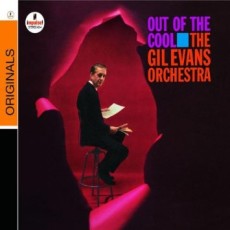
Daily Dose Of Jazz…
Gil Evans came into this world on May 13, 1912 in Toronto, Ontario, Canada as Ian Ernest Gilmore Green. His name was changed to his stepfather’s Evans early in his life. His family moved to Stockton, California where he spent most of his youth.
Between 1941 and 1948, Evans worked as an arranger for the Claude Thornhill Orchestra. His basement apartment behind a New York City Chinese laundry became a meeting place for musicians looking to develop new musical styles outside of the dominant bebop style of the day that included the leading bebop performer Charlie Parker, Gerry Mulligan and John Carisi.
In 1948, Gil collaborated with Miles Davis, Mulligan and others to create a nonet utilizing French horns and tubas keeping the big sound with less cost. The Davis-led group was booked for a week at the Royal Roost as an intermission group on the bill with the Count Basie Orchestra. Subsequently, Capitol Records recorded 12 numbers at three sessions in 1949 and 1950 that were reissued on the 1957 Miles Davis LP titled Birth Of The Cool. He was also instrumental in contributing behind the scenes to Davis’ classic quintet albums of the 1960s.
From 1957 onwards Evans recorded albums under his own name. He brought tubist Bill Barber, trumpeter Louis Mucci along with im and featured soloists Lee Konitz, Jimmy Cleveland, Steve Lacy, Johnny Coles and Cannonball Adderley. By 1965 he was arranging the big band tracks on Kenny Burrell’s Guitar Forms album.
Evans’ influence by Latin, Brazilian and Spanish composers Manuel de Falla and Joaquin Rodrigo as well as German expat Kurt Weill led him to create arrangements that included two basses, using Richard Davis, Paul Chambers, Ron Carter, Ben Tucker and Milt Hinton on many of his recordings. He was prolific in his recording until he became discouraged by the commercial direction Verve Records was taking with his arrangements for Astrud Gilberto’s Look To The Rainbow, causing him to take a hiatus from music.
During this period he began listening to Jimi Hendrix at the suggestion of his wife. He became interested in scoring the music of the rock guitarist, put together another orchestra in the Seventies and began working with in the free jazz and jazz rock idioms. He eventually released an album of arrangements of Hendrix’s music with John Abercrombie and RyoKawasaki and his ensembles featured electric guitars and basses, like that of Jaco Pastorious, from that date forward.
He would go on to release Where Flamingos Fly in 1981 with Coles, Harry Lookofsky, Richard Davis and Jimmy Knepper, Howard Johnson, Don Preston and Billy Harper. He created his Monday Night Orchestra in 1983 that became a staple for five years at Sweet Basil Jazz Club in Greenwich Village. Members of the band were Lew Soloff, Hiram Bullock, David Sanborn, Mark Eagan and Tom “Bones” Malone and Gil Goldstein among others. He recorded a big band album of The Police songs with Sting collaborating with apprentice arranger Maria Schneider.
Gil won two Grammy awards, has four films to his credit and was inducted into the Down Beat Jazz Hall of Fame in 1986. He ha a catalogue of eighteen studio albums, 16 live albums, arranged fifteen albums for Miles Davis, Hal McKusick, Helen Merrill, Johnny Mathis, Macy Lutes, Don Elliott, Astrud Gilberto and Kenny Burrell.
Pianist, composer, arranger and bandleader Gil Evans, who played an important part in the development of cool, modal, free and fusion styles of jazz, passed away of peritonitis in Cuernavaca, Mexico at the age of 75 on March 20, 1988.
![]()
More Posts: piano
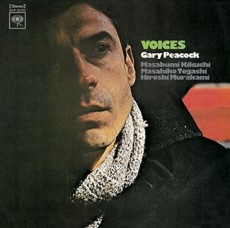
Daily Dose Of Jazz…
Gary Peacock was born May 12, 1935, in Burley, Idaho and studied the bass as a youth. After military service in Germany, during the early Sixties he worked on the West Coast with Barney Kessel, Bud Shank, Paul Bley and Art Pepper. Moving to New York he continued working with Bley as well as with Paul Motian in the Bill Evans Trio, and with Sunny Murray in the Albert Ayler trio. He also played some live dates with Miles Davis as a temporary substitute for Ron Carter.
In the late 1960s Peacock spent time in Japan, abandoning music temporarily to study Zen philosophy. After returning to the U. S. in 1972, he studied biology at the University of Washington, Seattle and taught music theory at Cornish College of the Arts from 1976 to 1983.
In 1983 Gary joined Keith Jarrett’s Standard Trio with Jack DeJohnette and the trio releaseded Standards Vol. 1 & 2 and Standards Live. Under Peacock’s leadership the trio recorded earlier in 1977 Tales of Another on the ECM label.
Peacock has recorded a dozen albums under his leadership, six releases as part of the group Tethered Moon and another sixty-two albums as a sideman with Bill Connors, Don Elis, Clare Fischer, Marc Copland, Marilyn Crispell, Barney Kessel, Prince Lasha, Sonny Simmons, Don Pullen, Bud Shank, Ravi Shankar, Ralph Towner, Mal Waldron, Tony Williams and Jimmy Woods to name a few.
He has composed for two film shorts, performed on three documentaries, performed as the Keith Jarrett Trio on the Most Martha soundtrack, and has appeared on television. Double bassist Gary Peacock continued to perform, tour and record until he passed away on September 4, 2020, at his home in Upstate New York. He was 85.
![]()
More Posts: bass


